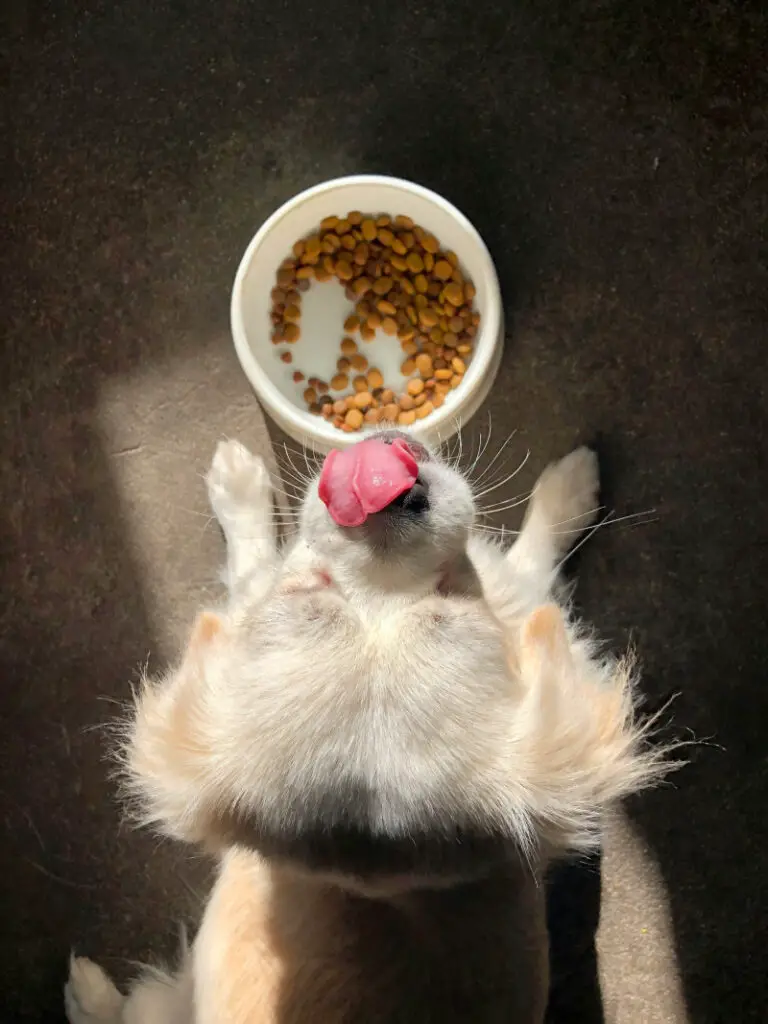It is normal that from time to time you feel tempted to share your own food with the dog. Many owners believe that if food is good for them, then it must be good for their pets as well; But this is not entirely true. While there are some human foods that are safe for dogs, there are others that can be potentially toxic. In this sense, fruits and vegetables are no exception.
While many of them are considered safe and healthy, others can harm the pet, trigger all kinds of digestive problems and even put their lives in danger.
Table of Contents
What fruits and vegetables can dogs eat?
What fruits and vegetables can dogs eat every day? Which ones are not good? How to give vegetables to my dog? Keep reading below to learn all that…and more.
Note. During the writing of this article, different sources specialized in veterinary health were consulted, including the digital magazine PetMD and the official website of the American Kennel Club (AKC).
Can dogs eat fruits and vegetables?
First of all, we will clarify one of the most frequent doubts: can dogs eat fruits and vegetables? The answer is yes.
Unlike cats, which are obligate carnivores, dogs are considered omnivores. That means they can eat plant matter in addition to meat. Wild dogs are known to obtain nutrients and dietary fiber from semi-digested vegetables in the stomach of their prey, as well as from herbs, flowers, seeds, berries, and fruits found in the wild.
For domestic dogs, most commercial dog foods contain meat, vegetables, fruits, and grains, providing all the nutrients your pet needs.
While it’s not essential to add more plant matter to your dog’s diet, that doesn’t mean you can’t. Just keep in mind that fruits and vegetables should represent 10%, or less, of the calories that the dog eats per day.
What are the recommended vegetables for dogs?
The following vegetables are considered suitable to include in a canine diet:
- Lettuce
- Spinach
- Chard
- Cabbage
- Kale
- Cauliflower
- Broccoli
- Brussels sprouts
- Carrot
- Beet
- Sweet potato
- Pumpkin
- Parsnip
- Celery
- Asparagus
- Green beans
- Edamame
- Peas
- Cucumber
Let’s see what kind of nutrients it provides and how you can prepare each of them…
Green leafy vegetables
Dogs can eat most of the vegetables in this group. In addition to being rich in vitamins A, C, K, calcium, iron, and potassium, they are a good source of fiber.
How to prepare green leaves for dogs? Just like humans, dogs get the most nutrients when they eat them raw, but that doesn’t mean they can’t eat them lightly cooked.
In this case, it is important to control the size of the portion; a small handful will suffice. Excessive or frequent consumption of green leaves can lead to kidney problems due to the high calcium content, as well as affect dogs with hypothyroidism.
Cauliflower
Great source of vitamin C, as well as a good source of vitamins K, B6, folic acid, and choline.
How to prepare cauliflower for dogs? Your dog probably likes to eat roasted cauliflower. Wash it well, add a splash of olive oil and take it to the oven to roast for 5-6 minutes on each side; the idea is that it is crispy, but tender.
Recommended Serving Size: 1 or 2 cauliflower florets, depending on the size of your doggy.
Broccoli
Great source of vitamins C and K; good source of vitamin A, folate, manganese, and fiber. Chewing broccoli stalks has been shown to act like a natural toothbrush that helps remove plaque.
How to prepare broccoli for dogs? Cut the broccoli into small pieces, wash very well, and steam for 6 to 8 minutes, until slightly tender, but still crisp and bright green.
Recommended Serving Size: 1 or 2 bite-sized broccoli florets.
Brussels sprouts
Rich in vitamins K and C; good source of vitamins A, B1, B6, folic acid, manganese, potassium, and fiber.
How to prepare Brussels sprouts for dogs? Wash them well and place them in plenty of water to boil for about 10 minutes (a little less for a crunchier texture).
Recommended Serving Size: ½ to 2 Brussels sprouts, depending on the size of the dog. As with broccoli, its excessive consumption in dogs can cause gas and stomach irritation.
“Cruciferous vegetables such as broccoli, cauliflower, and Brussels sprouts are often contraindicated for dogs with thyroid problems due to their goitrogenic properties.”
Carrot
Great source of beta-carotene, a precursor to vitamin A. It is also rich in vitamins K and C, potassium, and fiber.
How to prepare carrots for dogs? Dogs love to chew on raw carrots; Not only does this help calm their anxiety, but it’s great for cleaning their teeth.
If you want to cook it, wash a carrot well, remove its ends, cut it into approximately bite-sized pieces, and steam for 10 minutes, or until tender.
Recommended Serving Size: 1 or 2 bite-sized pieces.
Note. Raw carrots are difficult for some dogs to chew and swallow, which is why they can easily choke. If you see undigested carrot bits in your dog’s stool, make sure to only feed them cooked or cut them into smaller pieces.
Find everything you need to know in: Can Dogs Eat Carrots? Benefits and Contraindications.
Sweet potato
Sweet potato is a great source of vitamin A, vitamins C, B6, and B5, manganese, potassium, and fiber.
How to prepare sweet potatoes for dogs? Making a sweet potato puree for dogs is very simple; just wash, peel and cut a sweet potato into cubes, cook over low heat for 20-30 minutes and remove from heat when they feel completely tender when pricked. Finally, mash well with a fork.
Note: Some dogs love dried sweet potatoes, which are a great chew alternative.
Recommended Serving Size: Mix 1-2 tablespoons of mashed sweet potatoes into dry dog food.
Pumpkin
All pumpkin varieties are said to be safe for dogs. Apparently, they feel very comfortable with its taste. Pumpkin is not only rich in fiber, antioxidants, and vitamin A, but it also helps a lot to improve digestion.
This vegetable can be a good ally to relieve stomach upset when your dog is constipated or has diarrhea.
How to prepare pumpkins for dogs? As with the sweet potato, you can prepare pumpkin puree or give it to him in previously baked or steamed pieces. Of course, make sure that your dog only eats the meat of the pumpkin; he avoids giving her the seeds and skin.
Recommended Serving Size: You can replace up to a quarter of your dog’s food with pureed pumpkin.
Celery
Rich in water, fiber, and vitamins A, B, and C. In addition, celery is known to freshen the breath of dogs.
How to prepare celery for dogs? If you notice that your pet does not like to eat raw celery, try giving it to him in very small pieces or steamed.
Asparagus
Great source of vitamin K, as well as a good source of vitamins A, B1, B2, C, and E, folic acid, iron, copper, manganese, potassium, and fiber.
How to prepare asparagus for dogs? The part that is considered safe for dogs is just the tip of the stud; Taking into account that eating it raw can be difficult for them, the recommendation would be to wash them well and cook them briefly. They can be steamed or sautéed for 1-2 minutes. Two pieces are more than enough serving size.
Some dogs do not like the taste of these stem vegetables; others simply cannot tolerate the grinding sensation they cause on their teeth. Don’t worry if your dog doesn’t want to eat them.
Green beans
Good source of vitamins C, K, A, manganese, and fiber. They are easy to digest and dogs love their taste.
How to prepare beans for dogs? Although they can be eaten raw, some owners prefer to use the beans cooked; in that case, thoroughly wash the beans, cut off their ends and cook in boiling water for 10 minutes. Give them to the dog when they are fresh.
Recommended Serving Size: 1 or 2 kidney beans cut into bite-size pieces.
Edamame (soy)
Great source of protein, iron, fiber, vitamins K and B2, omega-3 fats, phosphorus, potassium, copper, and magnesium.
How to prepare edamame for dogs? It is recommended to steam the grains, without salt, for 5-10 minutes.
Recommended Serving Size: 1 to 5 shelled beans.
Note: Keep an eye on your dog while eating this type of grain. Being small, the pet could choke if it tries to swallow them all at the same time.
Peas
Great source of vitamins K and C; good source of vitamins A, B1, B2, B3, B6, and folic acid, minerals such as manganese, phosphorus, magnesium, copper, iron, zinc, potassium, protein, and fiber.
How to prepare peas for dogs? Simply cook the peas in boiling water for just 2-4 minutes, until they turn bright green.
Recommended serving size: 1 or 2 tablespoons of peas, depending on the size of the dog.
Note: If your regular dry dog food already contains grains as one of its main ingredients, then it’s not a good idea to feed it more fresh legumes on its own.
Caveat. According to a report from the FDA (Food and Drug Administration in the United States), there may be some link between the condition of canine dilated cardiomyopathy and the daily consumption of pet food that contains legumes as one of its main ingredients.
Sources:




